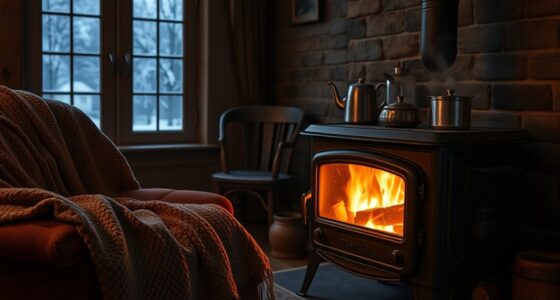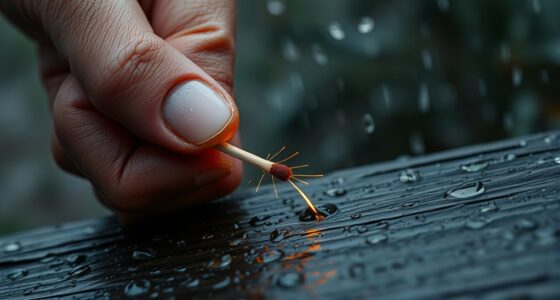To prevent creosote buildup, make sure you burn only dry, seasoned wood with moisture below 20%. Building small, hot fires instead of large, smoldering ones helps the combustion process, reducing creosote formation. Keep your damper fully open to allow proper airflow, which guarantees cleaner burning and less residue. Regular chimney maintenance combined with proper wood selection and burning techniques keeps your chimney safe and efficient. Continue exploring these tips for a cleaner, safer fireplace.
Key Takeaways
- Burn dry, seasoned wood with moisture below 20% to ensure cleaner combustion.
- Build small, hot fires instead of large, smoldering ones to reduce creosote formation.
- Keep dampers open enough to promote proper airflow and complete combustion.
- Avoid burning green or wet wood, which produces more smoke and creosote deposits.
- Regularly inspect and clean the chimney to remove creosote buildup and maintain safe operation.

Are you aware of how creosote buildup can pose serious fire hazards in your chimney? If you’re not, it’s time to understand how proper burning practices can substantially reduce that risk. Creosote is a sticky, flammable substance that forms when wood isn’t burned efficiently. The key to preventing excessive creosote is to focus on effective chimney maintenance and ensuring your wood has the right moisture content. When you pay attention to these elements, you keep your chimney safer and your fires cleaner.
First, proper chimney maintenance is essential. Regular inspections help you catch creosote buildup early before it becomes a dangerous problem. Professional chimney sweeping at least once a year removes accumulated creosote and other debris, reducing fire hazards. During your inspections, check for cracks, obstructions, or damage that could impede proper airflow. Good airflow ensures that the fire burns hotter and more completely, which in turn minimizes creosote formation. Remember, a poorly maintained chimney not only risks fire but also affects your heating efficiency and indoor air quality. Incorporating high-pressure cleaning techniques can further help in removing stubborn creosote deposits effectively.
Regular chimney inspections and sweeping prevent creosote buildup, reducing fire hazards and improving efficiency.
Another vital factor is wood moisture. Using properly seasoned firewood makes a dramatic difference in how cleanly and efficiently your fire burns. Freshly cut or green wood contains high moisture levels, often exceeding 20%, which causes the fire to smolder rather than burn hot. This smoldering process produces more creosote. To prevent this, always use seasoned wood that’s been properly dried—ideally for at least six to twelve months—until its moisture content drops below 20%. You can test moisture levels with a wood moisture meter or rely on visual cues like cracks in the wood or a lighter weight. When you burn dry wood, you generate a hotter, more complete combustion, drastically reducing creosote residues.
Furthermore, you should avoid burning green or wet wood, as these produce more smoke and unburned particles that settle on the chimney walls. It’s also smart to build small, hot fires rather than large, smoldering ones. Smaller fires burn hotter and more efficiently, helping to keep creosote levels low. Maintaining good airflow by keeping your damper open enough for proper combustion also plays a role in reducing creosote buildup. When you combine regular chimney maintenance with burning dry, seasoned wood, you’re actively working to prevent dangerous creosote accumulation and ensure your fireplace remains safe and efficient.
Frequently Asked Questions
How Can I Identify Creosote Buildup Early?
You can identify creosote buildup early by regularly inspecting your chimney. Look for a shiny, black, or tar-like glaze on the chimney walls during inspections, which indicates creosote. You might also notice a strong, smoky smell or increased smoke in your home. Conduct chimney inspections frequently to catch buildup before it becomes a fire safety hazard. Staying vigilant helps prevent chimney fires and keeps your home safe.
Are Certain Types of Wood Better for Preventing Creosote?
Think of your wood stove as a race car engine; choosing the right fuel makes all the difference. Hardwoods like oak and maple are better for preventing creosote because they burn hotter and cleaner. Avoid softwoods like pine, which produce more tar and soot. Use proper burning techniques—burn small, hot fires and ensure good airflow—to keep creosote at bay. These choices help your stove perform safely and efficiently.
How Often Should I Have My Chimney Inspected for Creosote?
You should have your chimney inspected at least once a year for creosote buildup. Regular inspections help identify creosote buildup early, preventing chimney fires. While you’re at it, make sure your chimney cap maintenance is up to date, as it keeps debris and moisture out. Also, follow stove placement tips to promote proper airflow and efficient burning, which reduces creosote formation and keeps your chimney cleaner longer.
Can Creosote Buildup Cause Chimney Fires?
Yes, creosote buildup can cause chimney fires. When creosote accumulates, it traps heat and ignites easily, especially if your chimney lacks proper insulation. Regularly dispose of ash safely and make certain your chimney is well-insulated to prevent hot spots that can ignite creosote. Keep your chimney clean and inspected often to avoid dangerous fires, and always follow safe burning practices to minimize creosote formation.
What Tools Are Best for Cleaning Creosote Safely?
Did you know that creosote buildup accounts for nearly 90% of chimney fires? To clean it safely, you should use chimney brushes designed specifically for your chimney size and type. Pair these with a quality creosote remover to loosen stubborn deposits. Always wear gloves and eye protection, and consider using a chimney vacuum or creosote scoop to avoid inhaling dangerous particles. Proper tools make your cleaning safer and more effective.
Conclusion
By burning your wood properly, you’re like a skilled chef ensuring every flame cooks just right. I once saw a friend avoid creosote buildup by following these steps, and his chimney stayed spotless all winter. Think of proper burning as tending a delicate garden—when you give it the right care, it flourishes without pests or mess. Stay vigilant, use seasoned wood, and you’ll keep your chimney safe and efficient season after season.









